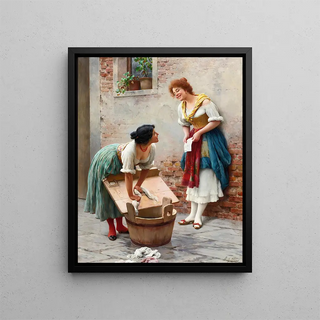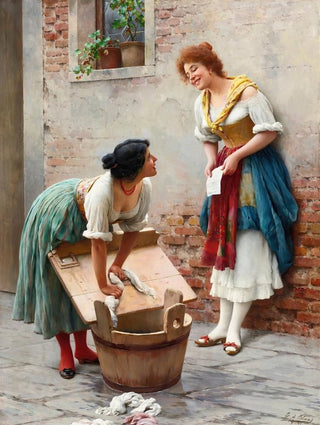Art print | Partager les nouvelles - Eugen von Blaas


View from behind

Frame (optional)
Art print Partager les nouvelles - Eugen von Blaas – Captivating introduction
In the fascinating world of art, some works manage to capture the essence of a moment with such intensity that they transcend time. "Partager les nouvelles" by Eugen von Blaas is one of these creations. This painting, imbued with life and dynamism, immerses us in a daily scene where the exchange of information takes place within an intimate setting. The piece evokes not only the conviviality of human interactions but also the richness of emotions emanating from each face. By contemplating this work, the viewer is invited to feel the warmth of human relationships, to project themselves into the moment, and to experience this communion of ideas and feelings.
Style and uniqueness of the work
Eugen von Blaas is distinguished by his skill in capturing the nuances of light and the details of human expressions. In "Partager les nouvelles," he uses a palette of vibrant colors that breathe new life into his characters. Each figure seems animated by its own energy, each gaze tells a story. Blaas's style, which combines realism with a touch of romanticism, creates an atmosphere that is both familiar and poetic. The drapery of the clothing, rendered with remarkable precision, adds a tactile dimension to the piece. The composition is carefully orchestrated, guiding the viewer’s gaze toward the center of the action, where the exchange of news unfolds with palpable intensity. This choice of subject, centered on humans and their interactions, reinforces the idea that art can be a mirror of society, reflecting its concerns and joys.
The artist and his influence
Eugen von Blaas, born in 1843 in Venice, is an artist whose career is marked by a deep admiration for Italian culture. His work aligns with the realism movement, but he does not limit himself to reproducing reality; he seeks to transcend it by adding an emotional dimension. Influenced by the masters of Venetian painting, Blaas develops his own style, characterized by meticulous attention to detail and sensitivity to variations in light. His impact on the artistic scene of his time is undeniable, and his legacy endures through

Matte finish

View from behind

Frame (optional)
Art print Partager les nouvelles - Eugen von Blaas – Captivating introduction
In the fascinating world of art, some works manage to capture the essence of a moment with such intensity that they transcend time. "Partager les nouvelles" by Eugen von Blaas is one of these creations. This painting, imbued with life and dynamism, immerses us in a daily scene where the exchange of information takes place within an intimate setting. The piece evokes not only the conviviality of human interactions but also the richness of emotions emanating from each face. By contemplating this work, the viewer is invited to feel the warmth of human relationships, to project themselves into the moment, and to experience this communion of ideas and feelings.
Style and uniqueness of the work
Eugen von Blaas is distinguished by his skill in capturing the nuances of light and the details of human expressions. In "Partager les nouvelles," he uses a palette of vibrant colors that breathe new life into his characters. Each figure seems animated by its own energy, each gaze tells a story. Blaas's style, which combines realism with a touch of romanticism, creates an atmosphere that is both familiar and poetic. The drapery of the clothing, rendered with remarkable precision, adds a tactile dimension to the piece. The composition is carefully orchestrated, guiding the viewer’s gaze toward the center of the action, where the exchange of news unfolds with palpable intensity. This choice of subject, centered on humans and their interactions, reinforces the idea that art can be a mirror of society, reflecting its concerns and joys.
The artist and his influence
Eugen von Blaas, born in 1843 in Venice, is an artist whose career is marked by a deep admiration for Italian culture. His work aligns with the realism movement, but he does not limit himself to reproducing reality; he seeks to transcend it by adding an emotional dimension. Influenced by the masters of Venetian painting, Blaas develops his own style, characterized by meticulous attention to detail and sensitivity to variations in light. His impact on the artistic scene of his time is undeniable, and his legacy endures through






